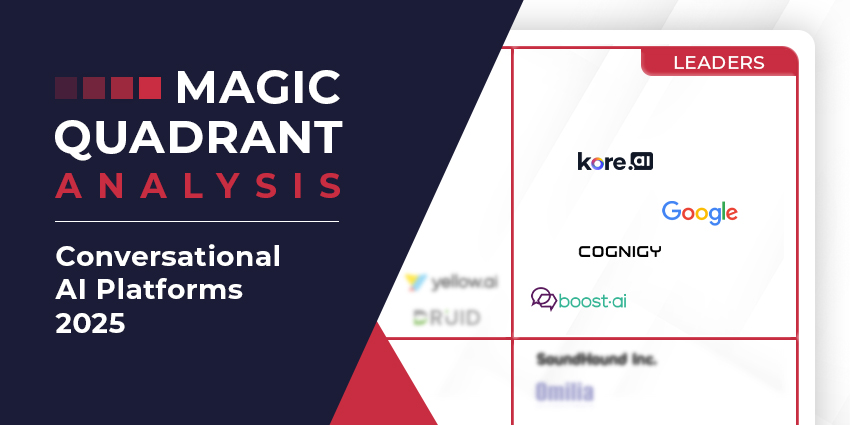Gartner has dropped its first Magic Quadrant study into the Conversational AI space in over two years.
The report, previously known as the “Gartner Magic Quadrant for Enterprise Conversational AI Platforms”, looks very different this time around.
Most notably, many vendors have dropped off. These include OneReach.ai (a former Leader), AWS (a former Challenger), and Openstream.ai (a former Visionary).
Meanwhile, Laiye, Aisera, [24]7.ai, Inbenta, Sinch, and eGain – all previously Niche Players – also no longer feature in the report.
Alongside these slips, the continued omission of Netomi, Uniphore, and Verint is surprising.
However, Gartner did add some key industry players. DRUID AI sprints into the Challenger quadrant. LivePerson and PolyAI enter the mix as Niche Players.
In terms of the Leaders, Google has surged to the top-right of the matrix, while Kore.ai and Cognigy cement their positions in the square. boost.ai enters the Leader quadrant, sliding across from the Challenger group.
IBM, Omilia, and Avaamo have exited the top-right square, earning Challenger, Visionary, and Niche Player spots, respectively.
SoundHound (formerly Amelia) has also dropped into the Visionary square from its Leader spot, while Sprinklr has sunk from a Challenger to the Niche Player group.
That’s a lot of change, compared with most other Magic Quadrant studies, likely underlining the significant impact that the rise of generative and agentic AI has had on the space.
The Definition of a Conversational AI Platform
Conversational AI platforms allow teams to build applications that simulate human interaction across voice and digital channels.
Thanks to industry-wide advancements, the platforms now provide no-code builders, multimodal capabilities, and dedicated conversational intelligence modules as a standard.
While typically deployed to automate customer service conversations, each vendor in this report also supports employee assistance and commerce, sales, and marketing automation use cases.
In doing so, they democratize conversational AI tooling, helping businesses operate more cohesively and efficiently.
That’s the breakdown, although Gartner includes an exhaustive list of mandatory and common features for conversational AI platforms in its report.
From there, the analyst evaluates 13 prominent platform providers, splitting them into four categories: Leaders, Challengers, Visionaries, and Niche Players. Here’s how they performed.
Gartner Magic Quadrant Leaders
Leaders in the Magic Quadrant couple a global base of satisfied customers across many industries with a commitment to continued innovation. They’ve also demonstrated an agile foundation to move with the latest industry trends and changes in customer requirements. This year’s Leaders are:
- Kore.ai
- Cognigy
- boost.ai
Google earns plaudits for its “AI research investment”, with Gartner citing its DeepMind initiative, research and development (R&D), streak, and collection of patents.
One such patent is for an on-device conversational application for consumers, allowing them to turn to leverage an AI agent when a business calls them. That beckons the future of machine-to-machine customer service.
However, its AI investment is also evident in its advanced Vertex AI capabilities, which include an emotional awareness feature, real-time video input, and support for “human-like” voices.
Alongside that investment, Gartner also commends the cloud giant for its “geographic presence” and “market responsiveness”.
Yet, it doesn’t note how Google is one of only two providers included in this report to own a first-party CCaaS solution. By making “Conversational Agents” available within that, Google opens up a significant opportunity for vendor consolidation.
Kore.ai
Kore.ai wins credit for its “product strength”. That covers its complete portfolio, which comprises three agentic AI platforms for customer service, employee support, and business productivity.
Yet, while the analyst lauds its portfolio strength, it doesn’t mention how Kore.ai is often first to market with solutions that go on to become conversational AI platform staples. A recent example is its Knowledge Graph for personalized, detailed, automated customer responses.
That said, Gartner does note Kore.ai’s “business model adaptability” and “employee development programs” as key strengths. The latter has helped the vendor triple its headcount in just four years.
Alongside all this, Kore.ai has boosted its market presence via close partnerships with leading CCaaS vendors, including AWS, Genesys, and Zoom. With Cognigy soon to be acquired by NiCE, it may reap further reward from these collaborations.
Cognigy
At the time of Gartner’s evaluation, NiCE hadn’t yet announced its agreement to acquire Cognigy.
That caused quite the stir, as Cognigy shares a diverse customer base with many of NiCE’s competitors, thanks to years of forging tight partnerships in the contact center space.
While those partnerships may now be up in the air, that customer diversity is a key strength for Cognigy, as it supports an array of use cases, with revenues spanning industries.
Gartner applauds this, alongside Cognigy’s “product capabilities” and “market understanding”.
As with Kore.ai, those capabilities are often ahead of their time. Its agent persona-building capability is probably the best recent example of this, something now becoming mainstream.
Finally, while Gartner doesn’t note this, the vendor’s large enterprise presence is notable, particularly across Europe, helping double Cognigy’s revenue from 2023 to 2024.
boost.ai
Surging into the Leader Quadrant, boost.ai impressed Gartner with its “responsiveness to market changes”, with the analyst citing its quick development of new enterprise-grade security, collaboration, and persona-building tools as examples.
Gartner also cites “sales strategy” and “customer experience” as core strengths. Indeed, the vendor is well-regarded for its combination of rapid deployments and high-touch support.
Yet, one critical differentiator for boost.ai, which the report neglects to mention, is its price point, which sits well below the market average for conversational AI platforms.
Over time, it has become the budget-friendly option for enterprises. That perception, matched with its robust presence on third-party marketplaces, makes it a highly accessible solution.
Gartner Magic Quadrant Challengers
Challengers in the Magic Quadrant present dependable solutions, backed by a strong operational and financial backbone. However, they typically focus on helping brands make incremental gains, not delivering pioneering innovation or influencing the market’s direction. This year’s Challengers are:
- Yellow.ai
- DRUID AI
- IBM
Yellow.ai
Yellow.ai garners acclaim from Gartner for its “market strategy” and “cross-industry feedback”, with the analyst citing high customer ratings for its platform’s “overall usability” and CX.
Its “pricing model” is another core strength, which the analyst describes as clear, predictable, and flexible. That’s increasingly crucial, as while there’s no single-best pricing model for conversational AI, vendors should be able to explain why it aligns with specific customer needs.
Notably, this goes back to another of Yellow.ai’s key strengths: execution. While Gartner didn’t highlight this, the vendor goes deep on different buying personas and their particular requirements. That enables it to translate pricing models and other key platform features for specific buyers.
However, Gartner did list cautions, hinting at why Yellow.ai missed out on the Leader Quadrant. These include “limited” investments in research and achieving global regular certificates.
DRUID AI
DRUID AI has surged in recent years, largely thanks to its ecosystem. That includes tight integrations with UIPath for robotic process transformation (RPA), Microsoft Power BI for analytics, and Genesys for voice automation.
Gartner underscores this and lauds how its broader partner strategy targets particular verticals, aligning with leading adjacent tech providers and consultancies across specific industries.
Alongside this, the vendor earns praise for its “business agility” and “customer experience”. The launch of an entire department dedicated to customer excellence emphasizes both strengths.
However, the report raises weaknesses, too. These include a below-average investment in research compared with other listed vendors, and a global footprint that doesn’t expand far beyond Europe and North America.
IBM
IBM, a longstanding leader in this space, has slipped into the Challenger quadrant.
Gartner cites confusing overlaps between its two conversational AI offerings: watsonx Orchestrate and watsonx Assistant, amongst its cautions.
However, it still offers several significant strengths. These include its “research investment”, “global presence”, and “marketing execution”.
A deep developer ecosystem supports the latter two plus points. That’s boosted by a vast AI education program that comprises its TechXchange community, webinars, and extensive case studies.
Surprisingly, Gartner didn’t mention IBM’s strengths in offering flexible deployment models and blending various forms of in-house AI. These remain massive differentiators for Big Blue.
Gartner Magic Quadrant Visionaries
Visionaries in the Magic Quadrant showcase a proven understanding of the market’s direction, which directs an innovative roadmap for meeting new customer requirements. Yet, they often lag Leaders on operational maturity, global support, and/or execution. This year’s Visionaries are:
- SoundHound AI
- Omilia
SoundHound AI
SoundHound AI snapped up Amelia in August 2024, a Leader in the previous Magic Quadrant for conversational AI.
Amelia worked with 15 global banks, giving SoundHound deep expertise in the finance sector.
Yet, SoundHound can also leverage its broader portfolio to deliver unique voice AI use cases for employee assistance and edge solutions to enable AI experiences that start in the car. These strengths pave the way for differentiative experiences.
Gartner didn’t note these as core strengths. It did, however, applaud the provider’s “market responsiveness”, “voice automation capabilities”, and “offering and delivery strategy”. The latter has underlines Amelia’s exposure as a white labelled solution within platforms like NiCE CXone Mpower Autopilot and Fujitsu Next Generation Service Desk.
However, that NiCE relationship may be in danger, given its Cognigy acquisition. Meanwhile, Gartner also raised concerns over SoundHound’s customer communication around Amelia’s roadmap.
Omilia
AWS and Google have recently left the voice biometrics space. Microsoft is retreating. However, Omilia is there, tying its tech together with voice automation. Given the voice biometric exits, that is fast becoming a differentiator.
Gartner didn’t pick up on this. Yet, it did note “enterprise customer understanding” as a core strength, sharing an example of how Omilia’s security innovation closely aligns with the priorities of enterprises in highly-regulated spaces.
Additionally, the analyst tagged its “research investment” and “pricing model transparency” as strengths. The latter is becoming increasingly critical in an industry with no single best approach to pricing, with vendors charging by virtual agent, action, workflows, and even action.
Nevertheless, the Magic Quadrant lists the limited number of “prebuilt connectors” and its “geographic coverage” as primary cautions.
Gartner Magic Quadrant Niche Players
Niche Players in the Magic Quadrant tend to excel in particular market segments, industries, or regions, with specialized tooling and/or support. Nevertheless, they lack the comprehensive, all-round proposition of market Leaders. This year’s Niche Players are:
- LivePerson
- Avaamo
- Sprinklr
- PolyAI
LivePerson
LivePerson has forged partnerships with legacy contact center vendors, including Avaya, to help larger on-premise organizations start to layer over conversational AI.
That strategy has helped LivePerson establish a cross-industry presence, enabling it to serve diverse needs, as highlighted by Gartner. Interestingly, such experience has also helped the vendor create reservoirs of education resources available to many customers.
Yet, back to the report. Other core strengths of LivePerson include “strategy adaptability” and “operations improvement”, with an example of the latter being the business’s center of excellence for generative AI.
In terms of cautions, Gartner notes that LivePerson’s platform is a “less differentiated offering” than other evaluated vendors. It also raises concerns over the provider’s “limited deployment flexibility”.
Avaamo
Avaamo has innovated in the conversational AI space for over ten years, accumulating a “market understanding” that aids its understand of buyers and market direction.
Gartner acknowledges this while lauding the vendor’s “cost of ownership clarity” and drive to deliver solutions with high “ease of use”.
Another strength many note of Avaamo is in its healthcare expertise, doubling down on what it claims is “the most complex industry first” and creating a specialized suite of agents.
While Avaamo wishes to expand this strategy, Gartner does warn that it may have over-rotated to healthcare, leaving its install base in other sectors a little isolated.
Sprinklr
Sprinklr’s conversational AI offering is just one part of a broader CX suite that includes CCaaS, social media management, and conversational intelligence. The suite is closely interlinked and enables customers the chance for provider consolidation.
That combination of conversational AI and intelligence often goes unappreciated. Yet, Sprinklr does it well, pulling insight for all interactions, whether they’re led by AI, humans, or both.
Gartner overlooks this, but highlights Sprinklr’s “marketing execution”, “partner network”, and “breadth of language support” as core strengths.
However, it underscores an issue in how Sprinklr delivers conversational AI through two UIs. The analyst also notes that the AI Agent Studio is only available at the highest end of its pricing.
PolyAI
PolyAI is best known for its voice automation capabilities, a focus that has helped it grow in a customer service space obsessed with cost savings. After all, voice is the channel most of its contacts flow through.
Gartner recognizes this as a key strength, alongside the provider’s “research investment” and “customer retention”, with the analyst underscoring its low customer churn.
One happy customer is Hopper, the travel company, with its Jo Lai, Head of Customer Experience at Hopper, recently sharing lessons from its PolyAI implementation with CX Today.
Nevertheless, its inflexible “consumption-based pricing” and immature “channel partner network” are among Gartner’s listed concerns.
Unpack more of CX Today’s adjacent Gartner Magic Quadrant rundowns below:
- Gartner Magic Quadrant for Contact Center as a Service (CCaaS) 2024
- Gartner Magic Quadrant for CRM Customer Engagement Center (CEC) 2024
- Gartner Magic Quadrant for Customer Data Platforms (CDPs) 2025







